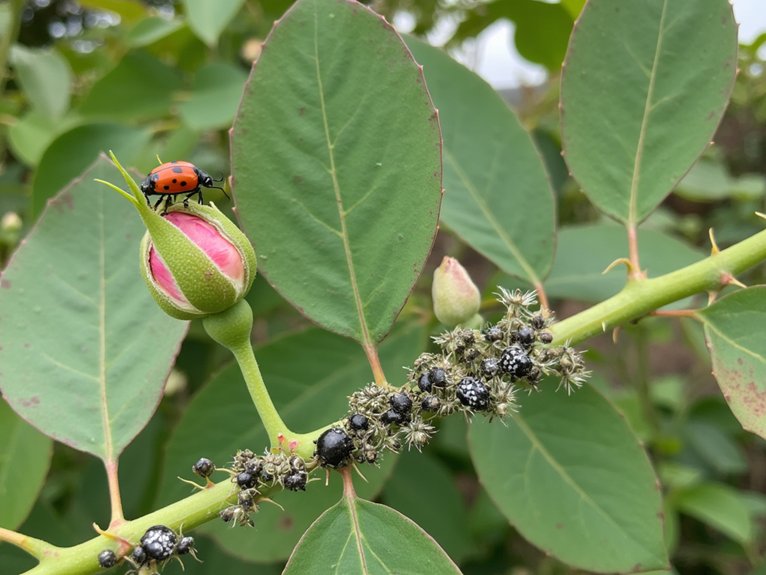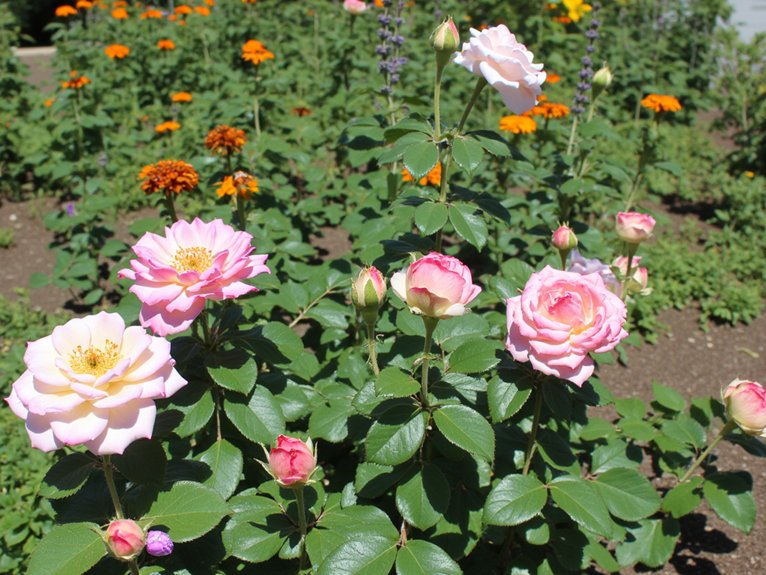Rose gardens face numerous hidden threats that can devastate prized blooms before gardeners notice the first signs. According to horticultural expert Dr. Sarah Chen, “The most destructive pests often work silently beneath leaves or inside stems.” These stealth attackers include microscopic mites, cunning aphids, and resourceful beetles that target different parts of the plant. Understanding these threats and their early warning signals helps gardeners prevent significant damage and protect their beloved flowers.
Contents
Common Rose Pests and Their Warning Signs

How do gardeners identify the subtle signs of pest infestation before their prized roses suffer significant damage? The earliest indicators often appear as curled leaves and sticky residue from aphids clustering near new growth. For aphid identification, look for small insects about ¼ inch long in green, brown, or yellow.
Sawfly damage reveals itself through transparent spots or skeletonized leaves, where larvae have eaten the undersides. Watch for small green caterpillar-like creatures measuring up to ½ inch. Regular inspection of leaf surfaces, particularly the undersides, allows gardeners to catch these pests before they cause extensive harm.
Natural Ways to Protect Your Rose Garden
While chemical pesticides offer quick solutions, gardeners can protect their roses naturally by cultivating a diverse and balanced garden ecosystem. Companion planting with herbs like lavender and thyme attracts beneficial insects that prey on common rose pests. For enhanced protection, organic repellents made from garlic, neem oil, or diluted soap solutions can deter unwanted visitors.
Regular monitoring and maintenance play significant roles in prevention. Remove debris around plants, prune affected areas promptly, and spray roses with strong water jets weekly to dislodge pests. Creating habitats for natural predators like ladybugs and lacewings helps maintain long-term pest control naturally.
Identifying Pest Damage Before It’s Too Late

Early recognition of pest damage empowers gardeners to protect their roses before infestations become severe. Key pest identification techniques include examining leaves for telltale signs: curled foliage suggests aphids, while transparent spots indicate sawfly larvae. Systematic damage assessment methods involve checking both sides of leaves, inspecting new growth, and monitoring flower buds.
During morning inspections, gardeners should look for silvery streaks on petals (thrips), sticky webbing (spider mites), or brown-edged holes (Japanese beetles). Pay special attention to leaf discoloration, deformed buds, and unusual spotting patterns. Regular monitoring enables early intervention through targeted, environmentally-conscious control measures.
Smart Prevention Strategies for Healthy Roses
Prevention offers rose gardeners the most effective defense against destructive pests. Building healthy soil through organic matter and maintaining proper drainage creates resilient plants that naturally resist infestations. “A strong rose is your best protection,” notes master gardener Sarah Chen.
Companion planting provides another layer of protection. Strategically placing lavender, garlic, or marigolds near roses attracts beneficial insects while deterring harmful ones. Regular monitoring allows gardeners to spot early warning signs before damage becomes severe. Remove plant debris promptly, maintain proper air circulation through pruning, and water at soil level to prevent creating conditions that pests prefer.
Creating a Balanced Garden Ecosystem

Understanding the delicate balance of nature provides gardeners with their most powerful pest management tool. Rather than rushing to eliminate pests with chemicals, focus on creating an environment that attracts beneficial insects and promotes soil health.
Establish diverse plantings around roses, including herbs like dill and fennel, which attract ladybugs and parasitic wasps. Maintain healthy soil through regular composting and mulching to support plant vigor. Allow some pest presence to sustain predator populations.
Monitor pest levels weekly during growing season. When intervention is needed, start with manual removal methods before considering stronger measures. This approach creates a self-regulating garden ecosystem.
